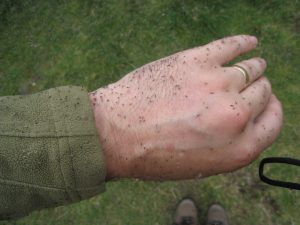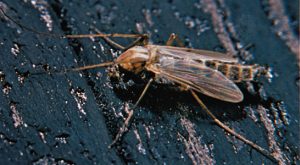They are often mistaken as mosquitoes because of their similar size and body shape. They are tiny flying insects with a wingspan of 2-3 mm. They are also called as the blind mosquitoes.
Guess who are those?
These little critters are tiny flies, about the size of a pinhead.
Male midges tend to have feathery antennae, something not seen on mosquitoes. Also, they rest with their two front legs hovering above the surface.
Midges can be found on along the coast, shores, and beds of any body of water. They are also found around ponds or streams in late afternoon and evening in swarms that produce a humming sound. Midges may breed in water or manure or under tree bark. They lay their eggs in shallow waters and worm-like larvae are hatched.
Due to their poor flying ability, they are often at the mercy of wind currents and can be blown into backyards. For this reason, they may be considered a nuisance to homeowners. They may take shelters under soffits, eaves etc.
They easily get attracted to artificial lights at night and thus are attracted towards many homes. Spiders are their predators which get attracted to the places where midges are found.
Only the female midges bite. They need a protein-rich meal of fresh blood in order to mature their eggs. Both the males and the females rely on sugar meals for energy for flight but the females need more than this to ensure the next generation. Female midges feed on the blood of birds as well as mammals. Each species has its own preferred choice of host. Most of the animals they bite are cattle, sheep, and deer but they can also feast on human skin, leaving an irritating bite mark that can swell up.
Biting midges are most active under calm conditions. They tend to bite around dawn and dusk but may continue to bite through the night. On overcast days they are also known to bite throughout the day. In order to develop more eggs, they need more protein and hunt down blood in order to boost their supplies.
When they bite, midges firstly pierce the skin before pumping saliva into the wound to stop the blood from clotting. It’s the saliva that then often produces a reaction in humans, which can lead to itchy red spots that can last minutes or days. In some extreme cases, people can also develop fluid-filled blisters and be swelling as a response to their midge bite. Most individuals are unaware they are being bitten at the time.
 Midges are often thought to be a problem unique to Scotland but that is untrue as they can be found in many Northern areas of England and Wales and, thanks, climate change, they seem to be spreading even further South and East each year. Areas such as the Highlands and Western Scotland suffer the worst when compared to the rest of the country.
Midges are often thought to be a problem unique to Scotland but that is untrue as they can be found in many Northern areas of England and Wales and, thanks, climate change, they seem to be spreading even further South and East each year. Areas such as the Highlands and Western Scotland suffer the worst when compared to the rest of the country.
Below is the evidence where midges are found causing trouble to humans:
Experts warn HUNDREDS OF BILLIONS of midges set to swarm the north of Scotland
By Mike Merritt – 14th June 2017
The number of the biting critters is officially up 100 percent on last year with a second bumper hatch due in weeks.
An incredible 139 billion midges are in the Highlands and Islands – 44.8 million per person.
Now leading midge expert Dr. Alison Blackwell said one trap in Glencoe caught 1.3 million of the biting beasties last week – double the number in the same period last year when weekly catches were just 680,000.
Hogan pushes Kamenetz on money for midges
By Dresser Reporter – The Baltimore Sun
Midges — those tiny swarming insects that drive people indoors — have become the latest subject of political jockeying between Gov. Larry Hogan and Baltimore County Executive Kevin Kamenetz.
On Wednesday, the Republican governor called on Kamenetz, a Democrat, to come up with $650,000 for a spraying program to combat the persistent midge nuisance on the Back River in the eastern part of the county.
Hogan, speaking during a meeting of the Board of Public Works, said his administration offered last week to pay half the cost of spraying the gnat-like insects this year and next if the county matches that sum.
This shows that such small creatures can cause a huge nuisance. This menace needs to be stopped. Also, the solution to stop the nuisance caused by the midges has to be effective and environment-friendly.
C Tech Corporation has a solution against midges menace.
We, at C Tech Corporation, have thought about this problem in detail and have come up with a viable solution. The solution is named as Combirepel™. We are the sole manufacturers of the product Combirepel™.
Our company believes in the principles of sustainability and eco-balance. We do not want to imbalance the cycle of life; therefore Combirepel™can be easily described as insect aversive, used also against all types of insects and which works on the mechanism of repellency. It means that it does not kill the target insects but only repel them, thus balancing the ecology and helping in maintaining the goal of sustainability. There are more than 500 species of insects against which this product works.
The product is available in the form of the masterbatch which can be incorporated into the base polymer of the polymeric applications like the pipes, cables, agricultural films, irrigation films, home appliances etc. to keep the pest away.
The product in the form of liquid concentrate can be mixed in paints and be applied on the interior and exterior of houses, schools, hospitals, offices, warehouses etc. to keep the pests out of these areas. The liquid concentrate is compatible with all types of paints and solvents.
The product available in the form of lacquer can be used as a topical application and can be used on the furniture, metal decors, wooden fences etc. to prevent the pest attack. The lacquer is compatible with most of the surfaces like wood, metal, concrete, ceramic, polymer etc.
Combirepel™ is thermally stable and does not degrade on exposure to heat and sunlight. It does not kill or harm the insect but repels them. It does not volatilize and does not degrade the soil. It is RoHS, RoHS2, ISO, REACH, APVMA, NEA compliant and FIFRA exempted.
Contact us at technical.marketing@ctechcorporation.com to keep the pests away.
Also, visit our websites:
http://www.ctechcorporation.com/
http://www.rodrepel.com/
http://www.termirepel.com/
http://www.combirepel.com/
Follow our Facebook pages at:
1] https://www.facebook.com/Combirepel-411710912249274/
2] https://www.facebook.com/Termirepel-104225413091251/
3] https://www.facebook.com/Rodrepel-120734974768048/
Follow us on our Twitter pages at:
1] https://twitter.com/rodrepel
2] https://twitter.com/termirepel
3] https://twitter.com/combirepel

